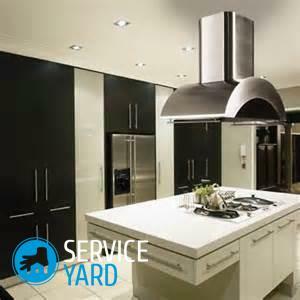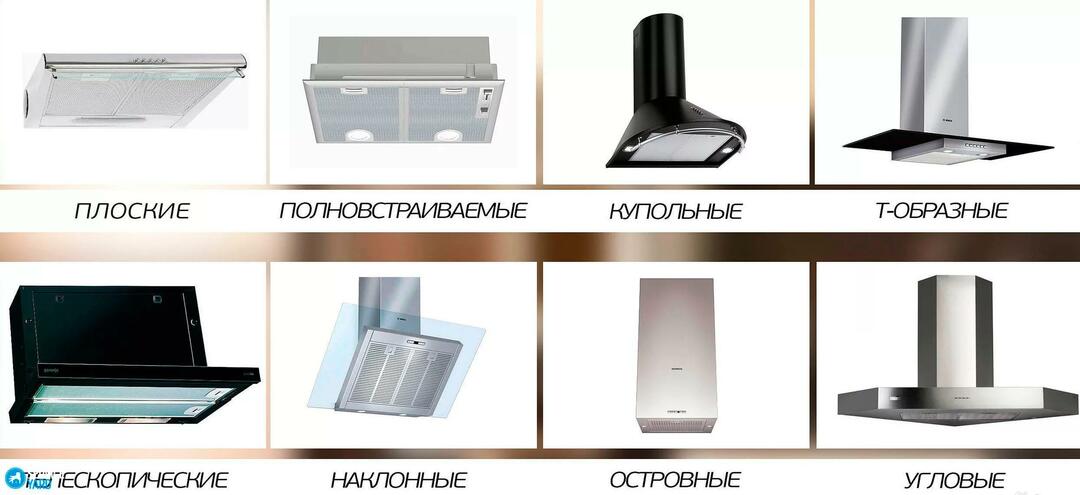
- Purpose of the kitchen hood
- Types of hoods for the kitchen
- Basic selection criteria for
More recently, the hood has been something unusual and outlandish, but today most housewives can no longer imagine their existence and daily activities in the kitchen without this appliance. In this article, we will talk about the main purpose of this type of equipment and understand what types of hoods for the kitchen are represented in the modern market.
to the contents ↑The purpose of the kitchen hood
Today, such a household appliance as an extractor, along with an oven and a sink, occupies a deserved place among the essentials. The popularity of such equipment is related to the following reasons:
- Modern extract helps fight fat drops that are constantly present in the kitchen.
- This device also eliminates the various flavors that inevitably occur during cooking and can cause significant discomfort to the occupants of the apartment.
- Exhaust hood above the stove allows you to get rid of particles of soot and burning, which significantly affects the cleanliness of the room.
- Built-in hood lighting system significantly increases the comfort of cooking in the dark.
Important! Installing the exhaust system over the hob is not a tribute to fashion trends, but a practical way to increase the comfort of your life and clean the apartment of unnecessary odors that irritate the human sense of smell.
to the table of contents ↑Types of hoods for the kitchen
The modern home appliance market is filled with a wide variety of exhaust systems of various design designs and functionalities. Therefore, deciding to purchase such equipment, it is necessary to understand what types of hoods for the kitchen exist and how they differ.
By mounting method
One of the main characteristics of the hood is the type of its installation. According to this criterion, all devices can be conditionally divided into the following categories.
Suspended
This type of equipment is installed directly above the slab surface and is a classic option. To save space in a small kitchen, the appliance can be placed under a hanging cupboard.
Important! This category of hoods has a number of advantages, the most significant of which are:
- compactness of equipment;
- its affordable cost;
- low noise operation.
Built-in
Products of this category are mounted in a special hanging cabinet and are almost invisible to others. Due to a wide variety of models built-in hoods are very popular among modern housewives.
Important! Such equipment can have different power, and therefore each consumer will be able to choose the most suitable unit for the kitchen.
Corner
These devices can be both built-in and dome type. However, they are united by an unusual form of construction, which allows for installation in a corner, thereby making even the most inconvenient connection of the walls functional and useful for the hostess.
Important! The advantages of such hoods include convenience in use and compactness.
Dome
This category of devices is characterized by its peculiar shape and rather large dimensions. Such units are attached directly to the wall above the kitchen stove. Often, the installation of such equipment requires air vent and other preparatory procedures.
Important! Such devices not only look solid, but also have high power levels, and therefore are suitable for medium and spacious kitchens.

Island
This type of kitchen hood is designed specifically for mounting above the surface of a slab that is part of a stand-alone module. Often, such appliances are installed in spacious and large kitchens, which justifies their high productivity. However, island hoods are the most expensive, therefore not available to every consumer.
Important! Choosing the type of attachment hood, you should pay attention not only to its design, but also to such characteristics as power, compactness, functionality, etc.
By the way of functioning of
Despite the wide range of such technique by the way of working, all products can beconditionally divided into two types of hoods for the kitchen.
Recirculating
This category of kitchen hoods can also be called coal or filter. At the heart of this equipment is a filter system. The principle of the extraction is based on the capture of polluted air in the internal reservoir of the structure, where it is cleaned with a two-level filtration system. After complete cleaning, air flows return to the kitchen.
Important! Equipment of this category has a number of undeniable advantages, the most significant of which are:
- maintaining a constant air temperature;
- natural ventilation of the room;
- compactness of dimensions.
However, it should be borne in mind that similar devices need regular replacement of the charcoal filter.
Flowing
The basic principle of the operation of such extracts is to divert polluted air outside the kitchen. The outlets of the exhaust system of this type are sent to the ventilation system at home or on the street.
Important! The main disadvantage of flow-type equipment is a significant heat loss in the winter.
Combined
Today, in the market of kitchen appliances, you can also find combined systems of hoods that, at the user's request, can work both in circulation and in flow mode. Such models will cost much more expensive, but their functionality and power are more interesting.
Based on the material used for the manufacture of
. Depending on the material used, the following types of kitchen hoods can be conventionally identified:
- plastic;
- metal;
- glass.
Important! Universal and the most simple in care, long-lived products are considered metal. Plastic costs cheaper, but the glass models are interesting to fit into an expensive, non-trivial interior in a modern style such as Hi-tech, Minimalism.
to the contents ↑Basic selection criteria
When selecting a hood in the kitchen, attention should be paid not only to the principle of operation and the method of fixing the appliance, but also to its following characteristics:
- The level of noise emitted. Too loud work of a kitchen hood can interfere with your rest, to bring to nothing all convenience and comfort of its use. For small and medium-sized premises it is recommended to install equipment, the noise level of which does not exceed 50 dB.
Important! The main influence on this extract factor is provided by the type of motor installed in it, and therefore give priority to products that best match the capabilities of your premises.
- Performance indicator. The level of productivity of the cooker hood is determined by the amount of polluted air that it can clean for an hour. However, this figure is directly dependent on the power of the built-in motor, respectively - noise and energy efficiency.
Important! Try to choose the exhaust structures that are designed for the premises corresponding to your kitchen area.
- Depending on the model features, the cooker hood can have a different type of illumination and the principle of the arrangement of the illumination elements.
- Also the types of control of the device - automatic or mechanical - can differ.
In this article we have told you about the purpose and the main varieties of hoods for the kitchen. We hope that this information will help you make the right choice and maximize comfort in the apartment.



